Chasing Shadows, Part 1
Welcome to the first week of Shadows over Innistrad previews. We're about to descend into madness (quite literally), and I invite you along for the ride. I'm going to introduce the design team, explain exactly how Shadow over Innistrad came to be, and even show off a cool preview card. So follow me if you're interested in learning how the design came together. Just be forewarned, this way lies madness.
Shadow Government
I always like to start my preview column by introducing you to the people who designed the set.
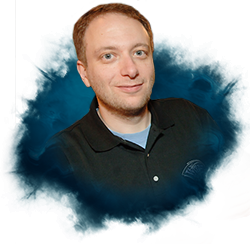
Mark Gottlieb (lead)
Mark has held many jobs in his numerous years in Magic R&D. He's been an editor, he's been the rules manager, and he's been a developer, but right now he is the design manager who oversees all six members of the design team (everyone but me and himself). Mark and I co-led Gatecrash, which was his first time leading a large set. Shadows over Innistrad was his first time leading a large set by himself, and as you will see, he did an outstanding job.
As his past jobs might indicate, Mark is a stickler for details, and Shadows over Innistrad had a lot of different facets to juggle. It was the first large spring set in the two-block paradigm. It was a return to one of the most popular worlds in Magic history (on my Head-to-Head: Planes competition on Twitter, it even beat out Ravnica in the finals by 30 votes out of 4,710 cast). It was the first set to pick up after the creation of the Gatewatch, and was a continuation in our ratcheting up of the story. As you will see, there was a lot to juggle, and Mark did a wonderful job of keeping all the balls in the air.

Adam Lee
Every other year, R&D does an off-site meeting where we get away to a local hotel to talk about many issues related to the game. As part of the off-site, we spend a few hours doing a series of talks where each member of R&D is allow to present on any Magic-related topic they wish in a five-minute micro-presentation. Adam chose to talk about his idea for a return to Innistrad. He'd come up with a cool story, which involved the denizens of Innistrad slowly going insane and our characters having to figure out what was wrong. Everyone loved Adam's idea, and when we were planning out our future sets, we stuck "return to Innistrad" on the board.
Adam served as the representative of the creative team on the design team. As he was the one who had done all the research and work on the new take on Innistrad, there was really no other choice for who was supposed to fill the role. Adam was a wonderful addition, and the set is all the richer for his involvement.

James Wyatt
Part way through design, Adam Lee ended up moving to the Dungeons & Dragons team and left the Shadows over Innistrad design team. Interestingly, his replacement was James who had previously worked on Dungeons & Dragons and had just moved to the Magic creative team. While Magic and Dungeons & Dragons are both fantasy properties, they're quite different from one another. James was a fast study though and quickly absorbed the world of Innistrad as the creative lead for the set. Shadows over Innistrad was carefully interwoven with the world and story, so James proved to be an invaluable member of the team.

Ken Nagle
Ken was given the task of being the lead designer on Eldritch Moon, the small set to follow Shadows over Innistrad. As is normal practice, we always like the lead of the small set to be on the team for the large set so that they are very familiar with the world and mechanics of the block, as most of it will carry over to the small set. I've written so many bios about Ken that there isn't much else left to say. He's a card-making machine and a huge asset to any design team he's on. That trend continued with Shadows over Innistrad.

Sam Stoddard
Sam was the development representative. Like Ken, he was going to be leading Eldritch Moon (development, though, instead of design). You all hopefully know Sam from his Latest Developments column here on DailyMTG. Sam did a great job of both being the voice of development on the set (helping cost cards and keeping a good curve, as well as making sure everything we did could be developed) and designing a lot of cards. Sam has strong opinions and makes a great sounding board for any design team he's on.

Andrew Veen
So it turns out we actually make games other than Magic. Andrew is in Duel Masters R&D, doing design on the popular trading card game we sell directly in Japan. We like to have cross-pollination in R&D (and throughout Wizards as a whole), so from time to time we have Duel Masters designers work on Magic. Andrew has worked on other Magic products, but I believe this is the first time he's worked on the design team of a Standard-legal expansion. Andrew was a total pleasure to work with and was delivering Ken Nagle-levels of card design, in both quantity and quality. I hope we'll be seeing more of him on Magic design.

Gavin Verhey
I keep wanting to say that Gavin is the newest member of the design team, and must remind myself that we have two newer members (Jackie Lee and Jules Robins). Of all the people in R&D, Gavin is one of the most well-rounded, with skills not just in design but also in development. He spent six months serving on the Magic brand team. He spent time overseeing Magic's branded play. He does cosplay at events (often dressed as Jace). He travels more than any human being I've ever met. He also has the ability to get involved in the most outlandish of stories (maybe one day I'll tell you the tale of when he fell down a volcano). Gavin is also one of the most enthusiastic people I've ever met, and it was a joy having him on the Shadows over Innistrad design team.

Mark Rosewater
And then there's me. Not much to say, as you listen to me talk about myself all the time. I'm always on the design teams to help out and keep an eye on what's happening.
Shadow Play
When design starts on any block returning to a world we've been to before, the first question we always ask is what mechanics should come back. To answer this question, we have to write up everything the previous block did. For Innistrad block, the board looked like this:
- Double-faced cards (Transform)
- Flashback
- Morbid
- Curses
- "Graveyard matters"
- Tribal (Humans, Spirits, Vampires, Werewolves, and Zombies)
- Fateful hour
- Undying
- Miracle
- Soulbond
- "Loner" mechanic
- "Flickering"
Let's go through our thoughts on the potential return of each of the above. Note that we had three outcomes—definitely, maybe, and definitely not.
Double-faced cards (Transform)—DEFINITELY
Nothing got more attention in original Innistrad than the double-faced cards. The team was unanimous in its belief that the audience would 100% expect the return of double-faced cards if we returned to Innistrad, so we treated it as a given.
Flashback—MAYBE
Flashback is an awesome mechanic. The problem is, it didn't premiere in Innistrad, so it doesn't have as much of a direct a correlation to the world as other things do.
Morbid—MAYBE
Morbid had the advantage of starting in Innistrad, so it had a little more direct correlation. It didn't play quite as well as flashback, though.
Curses—MAYBE
Curses were a mixed bag in original Innistrad. They were very popular with a minority of players, but the majority was lukewarm about them.
"Graveyard matters"—DEFINITELY
There's no easy way to make a Gothic horror setting without having the graveyard play some kind of role, so we knew this was a sure thing.
Tribal (Humans, Spirits, Vampires, Werewolves, and Zombies)—DEFINITELY
Humans and "monsters" are the main denizens of the world, so the creature types were for sure returning. We talked about whether or not there would be an expectation of a certain amount of tribal synergy, and we realized that the first Innistrad block had made that enough of a focus that yes, there would be expectations and we should be meeting them.
Fateful hour—DEFINITELY NOT
This mechanic was probably the most unpopular named keyword of the original Innistrad block, so we knew it wasn't returning.
Undying—MAYBE
Undying has design and development concerns, but it was popular. We could consider bringing it back.
Miracle—DEFINITELY NOT
There were two problems with miracle. First, we had made a conscious decision to return more to Innistrad the set than Innistrad the block, and miracle was tied to Avacyn Restored. Second, things were going horribly in the SOI story. This wasn't the time for miracles. No one was getting lucky.
Soulbond—DEFINITELY NOT
The same reasoning was held against soulbond. We were not focusing on Avacyn Restored and this was not a time of creatures coming together.
"Loner" mechanic—DEFINITELY NOT
This unnamed mechanic was the only thing to score lower than fateful hour, so we knew it wasn't coming back.
"Flickering"—DEFINITELY NOT
The set could have a few flickering effects ("Flickering" is slang for exiling a permanent and then bringing it back, usually at the end of turn, but on occasion right away), but there was no reason to notch it up into a larger theme for this set.
Here's our list after review:
DEFINITELY
- Double-faced cards (Transform)
- "Graveyard matters"
- Tribal (Humans, Spirits, Vampires, Werewolves, and Zombies)
MAYBE
- Flashback
- Morbid
- Curses
- Undying
DEFINITELY NOT
- Fateful hour
- Miracle
- Soulbond
- "Loner" mechanic
- "Flickering"
After looking everything over, we decided that we probably had enough in our "Definitely" column and that we were going to try and see if that would be enough to capture the feeling of Innistrad.
Shadow Boxing
When you start a design, you want something to focus on, and we chose to focus on the theme of Innistrad's growing madness. We liked that theme for two reasons. First, it helped us push Innistrad in a new direction. When revisiting a world, you want to return to things players enjoyed, but you also want to find a way to give the block a new perspective and not just make it a copy of the first visit. Second, we felt madness was a theme we could latch onto mechanically.
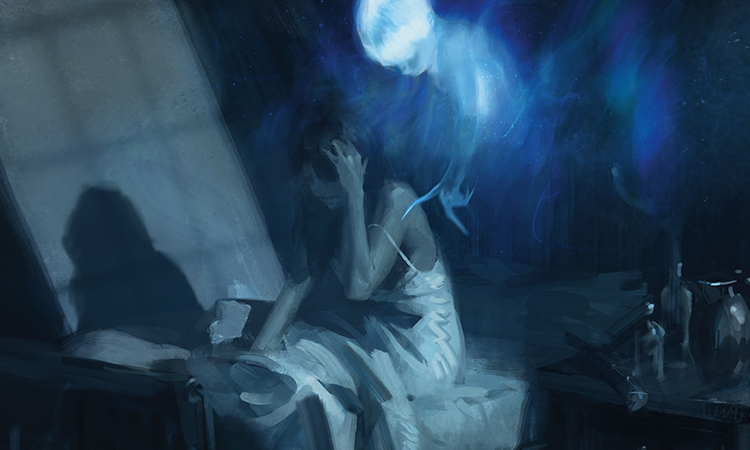
I guess I should begin with the elephant in the room, at least at the start of exploratory design. Our theme was madness. What mechanics could we use that convey the theme of madness? How about...madness? You see, Odyssey block, the graveyard-themed block that inspired the idea of Innistrad many years ago, had a mechanic called madness that allowed you to cast cards as they were being discarded. Madness had premiered in Torment (the middle set of the Odyssey block) and then returned in Time Spiral.
Madness was a powerful mechanic that was generally well-liked by the audience (the two things have a high correlation). Several weeks ago, I talked about the Storm Scale and used madness as an example of a mechanic that was an 8, something we'd only do if the stars aligned and we were able to fix the problems it had. Well, the stars aligned. We were doing a set with the theme of madness. The question was—could we solve the problems with it?
Madness had two main issues. One was developmental—it's a hard mechanic to balance and has the ability to be abused. The other was rules-based. Madness is one of those mechanics that works out of pure willpower from the rules, which just kind of says it works. In the modern day with things like digital play, we are more rigorous in making sure our rules work smoothly. If we were going to use madness, we'd have to solve a number of rules issues. (The issues themselves are a bit out of my area, which is why I can't give more details.)
Exploratory design decided to use madness. Design, when it started up, had to revisit the same decision and also decided that we'd try and see if we could make it work. It turns out, by the way, that Mark Gottlieb, the set's lead designer, and Dave Humpherys, the set's lead developer, were both big fans of madness.
Shadow Puppets
The big question of the design was, how exactly were we going to mechanically represent players going mad? This question was so important and key to the design that it went all the way back to exploratory design (led by Ethan Fleischer). We spent many weeks talking about it, and in the end decided to focus on the metaphor of the library being your mind (with your hand being your current thoughts) and losing cards from your library representing the idea of losing sanity.
We started with a more straightforward milling strategy ("milling" is a slang term referring to putting cards from the top of a player's library into their graveyard; the term is named after the card Millstone, which was the first card to have this effect), but soon realized that we weren't lining up with what the set was about. You weren't trying to make others crazy. You were trying to keep from driving yourself insane.
The solution we found was insanity counters. Certain cards, either when cast or when used, gave a player an insanity counter. For each instance of damage dealt to you, you had to mill cards equal to your number of insanity counters. For instance, let's say I cast two different spells, each of which gave me one insanity counter. If my opponent attacks with four creatures, two of which get through, I would have to mill two cards for each creature that deals damage to me, resulting in four cards getting milled. We had cards that gave you insanity counters to use and others that could give insanity counters to opponents.
Because insanity counters cared about how many things damaged you, not how big those things were, small, evasive creatures proved very good in the environment. (In the past, when we've tied milling one-to-one with damage, we found that players died before getting milled out.) We came up with an evasive mechanic called skulk (in design we called it sneak), which prevented a creature with power greater than the power of the creature with skulk from blocking it. The mechanic came about when we were brainstorming how to stop the combo of evasion with power pumping. Invisible Stalker in original Innistrad had proven very frustrating, because you could put Equipment or Auras on it and make the unblockable creature quite big, ending the game in just a few turns. Skulk has a built-in answer to this problem, because as the creature gets bigger, it starts to lose its evasion. Skulk stuck around all the way to print.
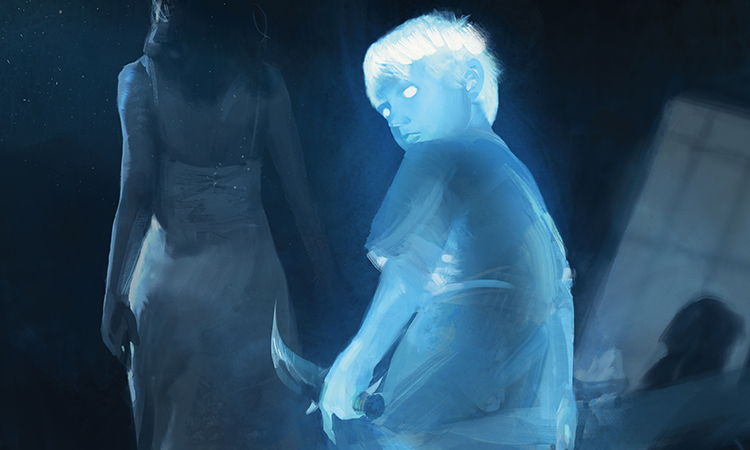
When the design started, we played around with the insanity counters, but found the mechanic was a bit fiddlier than we liked. We did enjoy the buildup of the graveyard as a symbol of insanity, though. Was there some way to still track the graveyard without needing to make use of counters? What if having your graveyard in a certain state represented you losing your sanity? We started with a very simple metric—the number of cards in your graveyard.
Interestingly, we had found ourselves back to another Odyssey mechanic—this time threshold. Threshold was a mechanic that upgraded cards that had it if there were seven or more cards in your graveyard. We played with threshold, but soon realized that while it was closer, it wasn't quite right. We started to think about other things we could count. We could count the number of creatures. We could count the number of noncreatures. We could count the number of colored cards. We could count the number of colorless cards.
At some point, we made the leap to counting not a particular thing but rather a certain number of things. Instead of how many blue cards there were in your graveyard, we looked for how many different colors were in your graveyard. Colors was problematic, though, because it made for very difficult deck building. We then stumbled upon card types. (And by "we," I mean Ken Nagle.) What if you had a certain number of card types? Every monocolored deck had access to all the card types.
At first, many on the design team were skeptical. The worry was it would be too hard to track, but the more we played with it, the more we liked it. It had an effect on deck building and gameplay. It proved to be easier to track than we initially worried. The timing of it worked out pretty well, and development found they could cost it. The mechanic would end up being called delirium and became a focal point for the set.
Shadow King
Next up was figuring out what we were going to do with double-faced cards. We knew the set needed to have some, but we wanted to advance them from what we did with them in Innistrad and Dark Ascension. We did this in two ways. First, we tried to innovate on their designs, pushing to design spaces we previously hadn't visited. Second, we spent a lot of time talking about whether or not double-faced cards could be a theme we cared about.
To address the first question, I'm going to show you today's preview card. Rather than tell you that we found ways to innovate, I decided it would be better to just show you.
Click to reveal!
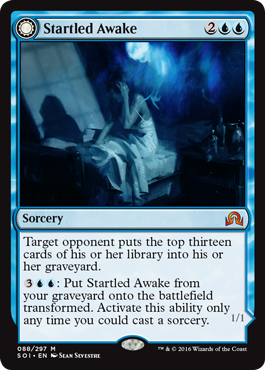
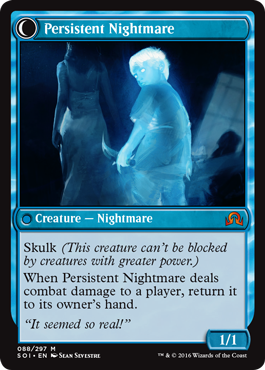
The idea behind this card was to use the double-faced technology to create a card that vacillates back and forth between two states, one a creature and one a spell. This spell was created specifically by Sam Stoddard as a means to demonstrate the kinds of design space we hadn't yet explored with double-faced cards.
As for the second idea, the design team embraced the idea of having a "double-faced cards matter" theme. Instead of one double-faced card per booster pack, we raised it to two and then made a bunch of cards that cared about things being or having been transformed. The green-blue Draft archetype became the "transformation matters" deck. In the end, though, this theme didn't play well enough to keep. We ended up lowering the as-fan of the double-faced cards from two per pack down to about 1.125 [Editor's note: This originally said 1.5. That was incorrect.], meaning you always get one and sometimes get two.
Shadow Realm
We had delirium, we had madness, we had skulk, and we had double-faced cards. The pieces were starting to come together, but there was still a lot of work left to do. How could we enable delirium? How did delirium tie into the other mechanics? Could we solve the issues with madness? How exactly were each of the tribes going to work mechanically?
As we were asking these questions, a new one was raised. The design team had been focusing on the madness, which was the focal point of the world, but the story was about mystery. Jace had come to Innistrad and he had to figure out what was going on. Yes, the design had captured the madness that Jace was investigating, but had it captured the investigation itself?
Join me next week when I share how all the pieces came together and how we found a mechanical way to tie into the mystery theme.
Until then, may you let the madness envelop you (you know, in a good way).
"Drive to Work #312—Limited Edition, Part 5"
This is part five of a six-part series on the design of Magic's very first set.
"Drive to Work #313—Limited Edition, Part 6"
This is part six of a six-part series on the design of Magic's very first set.
- Episode 313 Limited Edition, Part 6 (16.0 MB)
- Episode 312 Limited Edition, Part 5 (15.9 MB)
- Episode 311 Limited Edition, Part 4 (16.4 MB)
- Episode 310 Traveling (20.2 MB)
- Episode 309 Limited Edition, Part 3 (14.7 MB)

